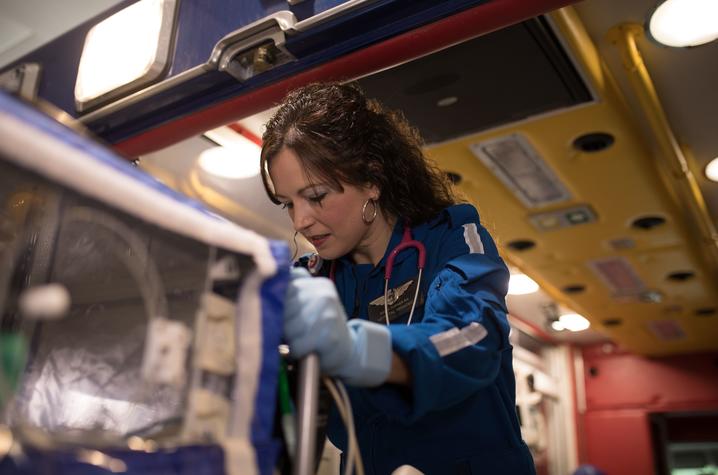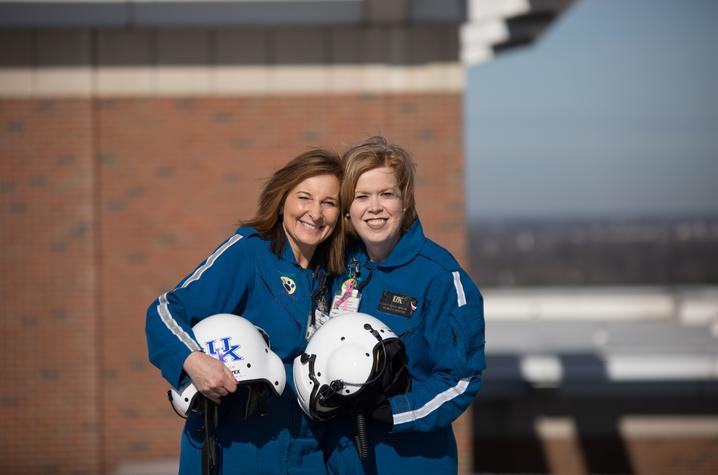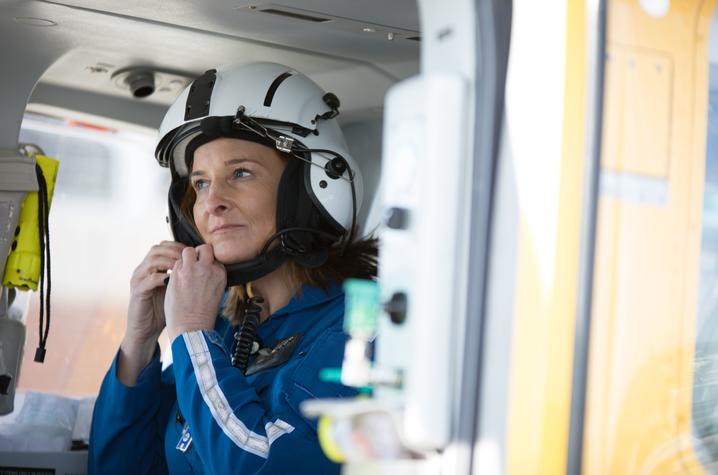Kentucky Kids Crew: Passion and compassion in action at UK HealthCare
LEXINGTON, Ky. (July 10, 2023) — 26 minutes. That’s all the time they have.
On one hand, it’s a decent amount of time to get something done: tackle some email, walk the dog the long way around, clean up after dinner.
But when you’re trying to get to someone — a child or baby — whose life could be at risk, 26 minutes pass in what feels like the blink of an eye. That’s why you’ve got to have highly competent, experienced emergency responders on the job. At UK HealthCare, there’s a team of top-notch responders who make up the Kentucky Kids Crew.
Directed by neonatal and pediatric intensive care specialists, the crew provides hospital-to-hospital critical care transportation for neonatal and pediatric patients. It is the only transport team in the region dedicated to newborns and children.
Since 1979, they have offered both ground and air transportation to physicians and health care facilities throughout Kentucky, West Virginia, Tennessee and Ohio. In 2012 UK HealthCare teamed up with PHI Air Medical in nearby London, which provides air transport in partnership with the UK-based team.
Its members include critical care nurses trained in advanced lifesaving procedures, emergency medical technicians who provide ground transport by ambulance, and a dedicated air transport team on duty 24/7 and ready to go — within 26 minutes — when they get a call. And they get a lot of calls.
A record-setting year
“This year it looks like we’re going to set a record,” said Dan Andrews, manager of neonatal and pediatric transport at Kentucky Children’s Hospital. “We’re on track to do 1,000 transports before June 30.”
Between 2017 and 2022, the average number of transports per year was just shy of 900. Andrews, who also manages the children's sedation and procedures unit, attributes the increase to a combination of factors including outreach efforts by UK specialty services and advancements in medicine.
The transport team began serving child patients in the 1990s, then gradually expanded the age range upward as capacity allowed. Now they offer transport for patients as old as 18.
The large majority of transports are completed by ground, while just 5% to 8% involve the helicopter. Whether to drive or fly depends on the distances involved, the seriousness and urgency of the case, and the weather.
Premature babies make up a large portion of the patients they transport. In fact, the unit provided only neonatal transport for the first dozen years they operated.
Newcomers and old-timers
Elizabeth “Lizzie” Rose is the newest member of the Kids Crew. She spent five years in the Neonatal ICU at Kentucky Children's Hospital and two years in the adult neurosurgery unit at Chandler Hospital before joining the transport team last fall.
Rose did her first air transport while still in orientation, accompanying two longtime team members on a flight to pick up an infant who had been born at home at just 30 weeks.
“When we got to the hospital there, the baby was cold and blue and really struggling,” said Rose.
“The three of us, we just fell into this rhythm and started acting as one unit to give this baby everything he needed,” said Rose. “We were able to intubate the baby so he was able to breathe again, and get his little lines in, and finally get him stable enough that we could put him in a little bed, so he could be taken for his mother to see him before we transported him."
Two-person teams have been the rule from the start, partly because of space and weight limits in the helicopters. Deb Rice and Tina McCoy, both pediatric transport nurses, have been leading the Kentucky Kids Crew since 1986 and often work together.
“For us, the stress is that we don’t have anybody but the two of us,” said Rice. “Whether a baby is not so sick or critically ill, it’s just us two.”
Both started out in the NICU and say the work they do now is radically different from a traditional 12-hour shift in a hospital. The differences are part of what has kept them on the team so long.
“The excitement, the autonomy, the adventure,” said Rice. “It’s exciting, but it’s a lot of responsibility.”
Under the best circumstances, medical emergencies put a lot of pressure on everyone involved. Add to it the possibility of difficult travel conditions and the fact that the transport team is in some ways, from pick-up to drop-off, on its own.
Rice and McCoy often use FaceTime or speaker phone to call support at the hospital they’re going to. But in many cases the patients rely largely on the unique combination of experience and knowledge that the two nurses bring to work with them.
Dedication is part of the job description
All that knowledge and experience are put to greater good throughout the hospital and beyond. Several of the nurses do outreach and training to strengthen ties with the health care institutions that call on their transport services and improve the overall pre-transport care of children in the region.
When they are not working with medical providers in the area, members of the crew can be found doing outreach and education with regional EMS services and community groups or teaching their colleagues in the hospitals of UK HealthCare. A few are certified to teach S.T.A.B.L.E., a widely implemented and respected training program that focuses on the post-resuscitation/pre-transport stabilization care of sick infants.
Kimberly Samuelson, a pediatric transport nurse, has been on the Kids Crew since 1997. The job has evolved in many ways over those 26 years, she said. But the heart of it is the same as it was when she started.
“Even though equipment has changed, policies have changed and people have come and gone, the one consistent has always been the care we give,” Samuelson said. “We come to work on the weekends, holidays and miss time with our families to give the best care to our smallest patients. That will never change.”
A call comes in, and the team goes out fast
The transport team uses state-of-the-art ambulances, helicopters and other equipment specially designed to meet the needs of their young patients. Vehicles are equipped as mobile intensive care units, with the same equipment used in the hospital’s intensive care units for children and newborns. That means the team can provide critical care while en route back to Lexington.
Every case is different, of course, and the team has to decide in the shortest of moments what to bring on each call.
For instance, different stretchers are needed to transport children of various sizes. Do they know the exact weight and height of the patient before they take off?
Depending on the situation, they may need different ventilators or cooling blankets to keep the patient stable until they arrive at UK.
The team stocks medications for each transport, but they can’t bring everything. They have to make these decisions quickly as they rush to respond to a call. In the photo above, neonatal pediatric transport nurse Kelli Turner checks supplies and equipment in an ambulance.
Once crew members arrive at the site, their priority is the patient. But often there are parents or other caregivers who may themselves need attention during the emergency. Sometimes family members are terrified or agitated, especially if they can’t travel with their child on the helicopter.
For a time, the COVID-19 health emergency even put limits on those who could ride in the ambulance.
Although Rose came on board after the worst of the COVID crisis, she has had to tell parents and other family members that they can’t ride along with their critically ill or injured child during transport.
“That is so upsetting,” said Rose. “I mean, you know that’s so scary for them.”
In five states, they're known as ‘The Baby Buggy’
Most of the crew’s transports are within a 200-mile radius of Lexington. The service covers areas in West Virginia, Virginia, Ohio, Tennessee and Eastern Kentucky, where health care providers anxiously await the team's arrival.
“My first exposure to the team was at another hospital,” Andrews said. “When they arrive outside the hospital, there’s a sigh of relief.”
In their 30-plus years with the Kentucky Kids Crew, Rice and McCoy have encountered thousands of children and their panicked families in medical emergencies. That takes its toll but, at the same time, offers its rewards.
“You’ve got to hold it together until you get away from the situation,” Rice said. “The few things we do before getting to the hospital, we start seeing improvements right away. We get a lot of gratification from that.”
Sometimes grief comes after the gratification. The 30-week preemie that Lizzie Rose helped resuscitate and transport during her first month on the job, for example, died at Kentucky Children’s Hospital nine days later.
Rose and the other nurses had frequently checked in on him. They got to know his parents, his brothers and sisters. It’s not unusual for crew members to look in on patients they've transported and to stay in touch for months or years afterward. But this time, they didn’t have the chance.
“That was so hard,” Rose said. “But you have to remind yourself, it’s not always like that. Sometimes — often — there are cases with really great outcomes. And if the outcome isn’t great, at least you know that you’ve made a difference in these people’s lives."
Some days are really hard
Back when the transport service first got going, the nurses took Polaroids with the baby or child and left them with the parents, to help them maintain an essential connection and remember that their child was in good hands.
“We had a family in 1986 who had a Polaroid, and they said they still have it in their baby book,” McCoy said. “We don’t know how many baby books we’re in!”
When the crew has hard days or feels like things aren’t going great, Andrews tells them to think about how many baby books they are in. He reminds them that they are part of many people’s first memories of their babies, and that those memories are often really good memories.
"People tell us ‘thank you’ for that time,” said Rose. “Like, ‘thank you so much for just letting me hold my baby’s hand before he passed away’.”
Being a member of the Kentucky Kids Crew is not for the faint of heart. But for those who choose to answer the call, their hearts are absolutely in it.
UK HealthCare is the hospitals and clinics of the University of Kentucky. But it is so much more. It is more than 10,000 dedicated health care professionals committed to providing advanced subspecialty care for the most critically injured and ill patients from the Commonwealth and beyond. It also is the home of the state’s only National Cancer Institute (NCI)-designated Comprehensive Cancer Center, a Level IV Neonatal Intensive Care Unit that cares for the tiniest and sickest newborns and the region’s only Level 1 trauma center.
As an academic research institution, we are continuously pursuing the next generation of cures, treatments, protocols and policies. Our discoveries have the potential to change what’s medically possible within our lifetimes. Our educators and thought leaders are transforming the health care landscape as our six health professions colleges teach the next generation of doctors, nurses, pharmacists and other health care professionals, spreading the highest standards of care. UK HealthCare is the power of advanced medicine committed to creating a healthier Kentucky, now and for generations to come.








